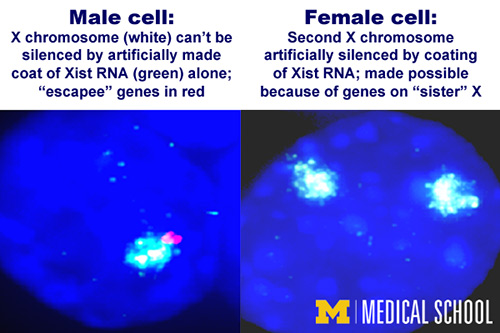![Left: Researchers used artificial means to try to silence the sole X in a male nucleus (blue). They found that the Xist RNA coating (green) of the sole X-chromosome (white) was insufficiently extensive to silence the X-linked genes (red). Right: In a female cell nucleus, the Xist RNA coating succeeded in silencing the genes on the second white X chromosome. Genes on the first, already silent, X were able to aid the process. [Kalantry Lab, University of Michigan Medical School]](https://genengnews.com/wp-content/uploads/2018/08/Jan11_2016_UnivMichMedSchl_Xist1574334231-1.jpg)
Left: Researchers used artificial means to try to silence the sole X in a male nucleus (blue). They found that the Xist RNA coating (green) of the sole X-chromosome (white) was insufficiently extensive to silence the X-linked genes (red). Right: In a female cell nucleus, the Xist RNA coating succeeded in silencing the genes on the second white X chromosome. Genes on the first, already silent, X were able to aid the process. [Kalantry Lab, University of Michigan Medical School]
The Xist gene, short for X-inactive specific transcript, is necessary for the silencing of one of the two X chromosomes in female mammals, but it is not sufficient alone. Other factors must come into play, some of which, like the Xist gene, reside on X chromosomes and, crucially, escape silencing themselves.
Because the genes are expressed on both chromosomes in female cells—both the unsilenced chromosome and the mostly silenced chromosome—the factors that assist Xist exert a dosing effect that cannot be matched by the single X chromosome that exists in male cells. And so, these factors suggest ways to counteract X-linked diseases in girls and women, even if they offer less leeway in treating males with X-linked diseases.
Xist, unlike most genes, doesn't tell cells to produce a protein. Instead, it produces Xist RNA, which physically coats one of the two X chromosomes in female cells. It does not, however, coat all genes. Some remain active even if they reside on the inactive X chromosome. Among these genes are factors that not only help Xist-silenced X chromosomes in female cells, but also somehow fail to silence the X chromosome in male cells.
To study this discrepancy between male XY cells and female XX cells, scientists based at the University of Michigan Medical School attempted to silence the sole X chromosome in male stem cells from mice by turning Xist on artificially. As it turns out, they could silence the X chromosome genes only partially. They reasoned that only limited silencing was possible because the male cells had no “twin sister” X chromosome to contribute the genes needed to finish the silencing job.
When the researchers used female cells that had one X that was already inactivated—and therefore had the same number of active X-chromosome as in males—they were still able to silence the active X when they artificially turned Xist on from that chromosome. The difference was that the female cells had higher levels of products made by “escapee” genes.
Details of this work appeared January 6 in the Proceedings of the National Academy of Sciences, in an article entitled, “Sex-specific silencing of X-linked genes by Xist RNA.” This article described how the researchers ectopically induced endogenous Xist by ablating the antisense repressor Tsix in mice. The researchers subsequently found that ectopic Xist RNA induction and subsequent X-linked gene silencing is sex specific in embryos and in differentiating embryonic stem cells (ESCs) and epiblast stem cells (EpiSCs).
“A higher frequency of X(ΔTsix)Y male cells displayed ectopic Xist RNA coating compared with X(ΔTsix)X female cells,” wrote the authors of the PNAS article. “This increase reflected the inability of X(ΔTsix)Y cells to efficiently silence X-linked genes compared with X(ΔTsix)X cells, despite equivalent Xist RNA induction and coating. Silencing of genes on both Xs resulted in significantly reduced proliferation and increased cell death in X(ΔTsix)X female cells relative to X(ΔTsix)Y male cells.
The researchers found comparable silencing in differentiating XY and XX ESCs, excluding the Y chromosome and instead implicating the X chromosome dose as the source of the sex-specific differences. Because X(ΔTsix)X female embryonic epiblast cells and EpiSCs harbor an inactivated X chromosome prior to ectopic inactivation of the active XΔTsix X chromosome, the researchers propose that the increased expression of one or more X-inactivation escapees activates Xist and, separately, helps trigger X-linked gene silencing.
“Our results suggest that both Xist induction and X-linked gene silencing are orchestrated by the handful of genes that do not undergo X inactivation in females,” the authors concluded. “The increased dosage of one or more such factors in females vs. males may explain why females undergo X inactivation and males do not.”
A wide range of relatively rare diseases—as well as relatively common conditions such as autism, hemophilia, and muscular dystrophy—are linked to problems with genes found on the X chromosome. Many of them have an effect on an individual's thinking and memory capacity, as well as other aspects of cognition and intelligence.
“In females, we could envision 'reawakening' a healthy copy of an X-linked gene on the inactive X chromosome, by modulating the dose of these so-called escapee genes and ameliorating the effects of the unhealthy copy,” noted the study’s senior author, Sundeep Kalantry, Ph.D.
Unfortunately, this approach probably won't help males with X-linked diseases because they only have a single X chromosome in each cell and inactivating it would be harmful.
Dr. Kalantry said that his team is zeroing in on the specific X inactivation escapee genes that first allow for Xist RNA to be expressed and then work with Xist to make silencing possible.


